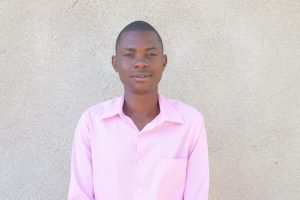At the Tigoi Girls Secondary School, 2,100 students and 61 staff members struggle to access sufficient water. They rely on piped water, which is available only twice a week and is never enough for their large school. Their only other option is to pay for water delivery, which causes tuition to skyrocket and hinders students' opportunities for education.

Students collecting water.
"The water is supplied to the school through a water boozer (water delivery). The carrying capacity of the boozer is around 3,000 liters. This is not enough to serve the large population. Water is supplied through [a] piped scheme that is overstretched by the community members, schools, churches, and other institutions that [are] entirely dependent on it. The piped water is pumped twice a week, which is never enough to last them a day, which makes the school seek the services of [a] water boozer. These sources have left the school to charge students extra fees to cater for water bills. The school is in dire need of water on its premises to support the school activities," shared Field Officer Amos Emisiko.

The water piped into the school is stored in this tank.
The Tigoi Girls Secondary School stands out in its achievements. They also stand out in their water crisis.
"The population currently is about 2,100, and this makes the school in dire need of water, especially because it is a boarding school. The school is ranked as one of the best in the region as a result of [the] successes they have made in academics and sports. The school is recognized as [the] giants of East Africa in basketball games as they have lifted this coveted trophy four times," Amos continued.

Students playing basketball.
Hours a day are leached from the students' lives—time that should be dedicated to learning or playing. Unfortunately, that's not the only thing this water crisis steals. It also impacts the students' safety.

On the hunt for water.
It is not unusual during the dry season for the school rain tanks to be dry and the water boozer to be unable to deliver water. When that happens, the students are required to leave the school campus and collect water from the community spring. It is overcrowded and steals even more of the student's time.
"The population in this school is too high, so we are forced to make very long queues when fetching water at the rainwater tanks or at the community spring. This causes time wastage. The exposure of going to fetch water in the community spring poses [a] danger to us girls, and our safety is not guaranteed. The water in the tanks depletes so fast, and most of us fail to fetch it," shared Julie, a student.

Julie.
"I am worried about safety at the current water source because of the presence of [a] large population. Sometimes, especially during the dry seasons, we lack water completely, and our form four students are sent to fetch water from the main source (the spring). The interactions between community members and the students might subject them to harm when they come across someone with bad intentions," said teacher David Ananda, 33.

Teacher David Ananda collecting water.
When so much energy is spent collecting water and staying safe, it makes it hard for them to focus even when they do get to class on time. Their hygiene suffers as well, and when hygiene is lacking, it leads to decreased self-esteem, affecting the girls' future potential.

Class in session.
"Lack of water makes the students skip cleaning [and] classes, toilets don't get washed, and they are forced to wear dirty clothes. Lack of water also makes the students walk long distances to fetch water. When the tanks available in the school fail to hold enough water for all of them, [the] form four students go to [the] spring, which is located two and a half kilometers (1.5 miles) away. Going this far to fetch water makes the students settle late in class," Mr. Ananda continued.

Teacher David Ananda.
Installing a well on campus will change the narrative for David and his students.
"The students, teachers, support staff, and community members will have a reliable water point. They will not have to worry about making long queues to fetch water because of the alternative water point provided by The Water Project. The school will also be able to implement various projects that are intended to make the school grow like building new infrastructure. The school would like to extend the waterpoints with tanks so that [they] can be able to accommodate several taps. With this new plan, many students will be able to fetch water at the same time, and this will help save time," concluded Amos.

Teachers like David at the Tigoi Girls Secondary School will have the opportunity to give their students a better education. The hours a day spent collecting water will be able to be spent in the classroom and doing other crucial activities to improve the girl's future.
Steps Toward a Solution
Our technical experts worked with the local community to identify the most effective solution to their water crisis. They decided to drill a borehole well, construct a platform for the well, and attach a hand pump.
Well
Abundant water often lies just beneath our feet. Aquifers—natural underground rivers—flow through layers of sediment and rock, offering a constant supply of safe water. A borehole well is drilled deep into the earth to access this naturally filtered and protected water. We penetrate meters, sometimes even hundreds of meters, of soil, silt, rock, and more to reach the water underground. Once found, we construct a platform for the well and attach a hand pump. The community gains a safe, enclosed water source capable of providing approximately five gallons of water per minute. Learn more here!
Handwashing Stations
Alongside each water source, we install two gravity-fed handwashing stations, enabling everyone at the school to wash their hands. Handwashing is crucial for preventing water-related illnesses within the school and community. Student “health clubs” maintain the stations, fill them with water, and supply them with soap, which we often teach them how to make.
Latrines
We will construct two Ventilated Improved Pit (VIP) latrine blocks designed to prevent fecal disease transmission. Each latrine features a cement floor, making it easy to use and clean regularly.
School Education & Ownership
Hygiene and sanitation training are integral to our water projects. Training is tailored to each school's specific needs and includes key topics such as proper water handling, improved hygiene practices, disease transmission prevention, and care of the new water point.
To ensure a lasting impact, we support forming a student health club composed of elected student representatives and a teacher. These clubs promote hygiene practices schoolwide and keep handwashing stations well-stocked. This student-led model encourages a sense of ownership and responsibility.
Safe water and improved hygiene habits foster a healthier future for everyone in the school and the surrounding community.

 Borehole Well and Hand Pump
Borehole Well and Hand Pump
 Rehabilitation Project
Rehabilitation Project




















